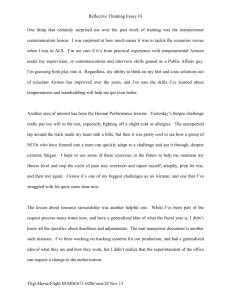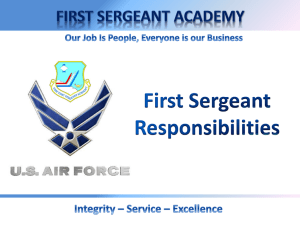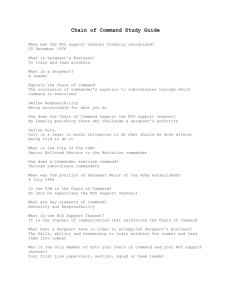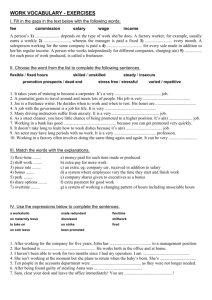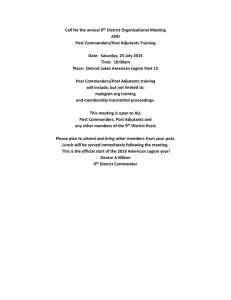stripes for exceptional performers (step)
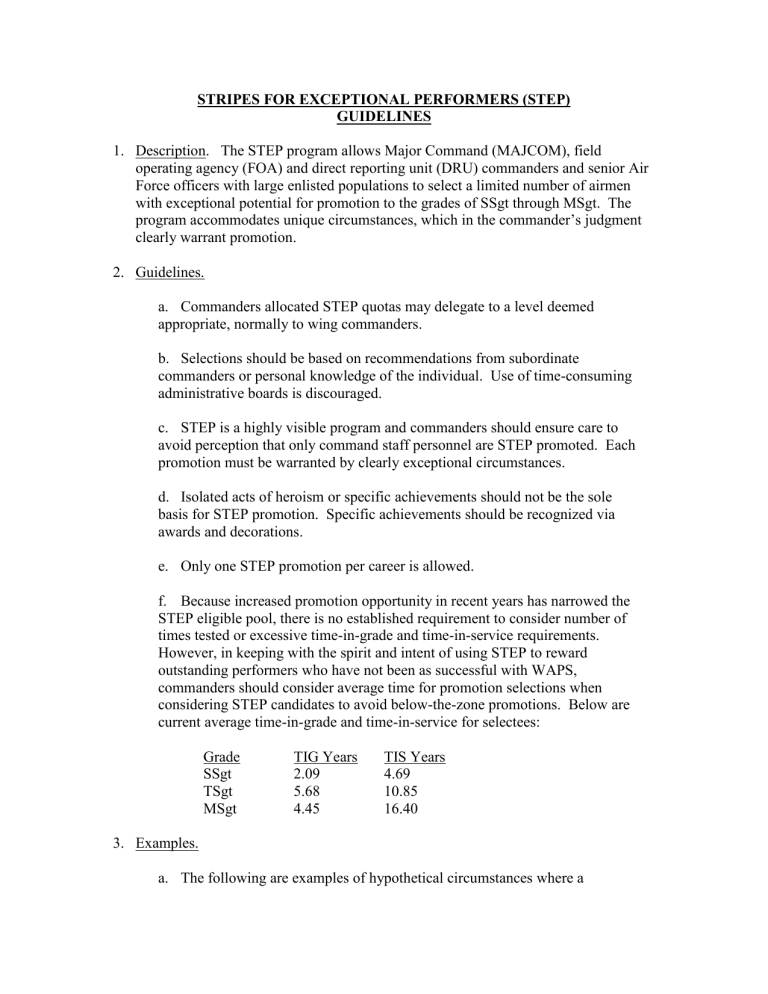
STRIPES FOR EXCEPTIONAL PERFORMERS (STEP)
GUIDELINES
1.
Description. The STEP program allows Major Command (MAJCOM), field operating agency (FOA) and direct reporting unit (DRU) commanders and senior Air
Force officers with large enlisted populations to select a limited number of airmen with exceptional potential for promotion to the grades of SSgt through MSgt. The program accommodates unique circumstances, which in the commander’s judgment clearly warrant promotion.
2.
Guidelines. a.
Commanders allocated STEP quotas may delegate to a level deemed appropriate, normally to wing commanders. b.
Selections should be based on recommendations from subordinate commanders or personal knowledge of the individual. Use of time-consuming administrative boards is discouraged. c.
STEP is a highly visible program and commanders should ensure care to avoid perception that only command staff personnel are STEP promoted. Each promotion must be warranted by clearly exceptional circumstances. d.
Isolated acts of heroism or specific achievements should not be the sole basis for STEP promotion. Specific achievements should be recognized via awards and decorations. e.
Only one STEP promotion per career is allowed. f.
Because increased promotion opportunity in recent years has narrowed the
STEP eligible pool, there is no established requirement to consider number of times tested or excessive time-in-grade and time-in-service requirements.
However, in keeping with the spirit and intent of using STEP to reward outstanding performers who have not been as successful with WAPS, commanders should consider average time for promotion selections when considering STEP candidates to avoid below-the-zone promotions. Below are current average time-in-grade and time-in-service for selectees:
Grade
SSgt
TSgt
MSgt
TIG Years
2.09
5.68
4.45
TIS Years
4.69
10.85
16.40
3.
Examples. a.
The following are examples of hypothetical circumstances where a
commander might determine that an airman should be STEP promoted:
(1) Technical Sergeant Able has been assigned to Recruiting Zone X for about one year. Historically, Zone X has been one of the least productive recruiting detachments. It is located in a geographic area which has a particularly difficult market. During the past year, Sergeant
Able has been directly responsible for recruiting three times the number of enlistees recruited in the previous high production year—without any reduction in the average quality of enlistees. In addition, many of the innovative programs Sergeant Able implemented will be sources of future enlistees. He has average time-in-service and time-in-grade compared to his peers.
(2) During the past year, Staff Sergeant Baker took part in two operational exercises of long duration. Based on unprogrammed changes in manning for six months of this period, she filled her own position and that of a senior master sergeant, who had been reassigned for humanitarian reasons.
The performance of her work unit was judged noteworthy in exercise debrief sessions based on major improvements in four phases of the exercise. She has average time-in-service and time-in-grade compared to her peers. b.
The following are examples of hypothetical circumstances in which commander may determine an airman should not be promoted under STEP:
(1) Technical Sergeant Cane has served over 19 years and has recently been notified of nonselection for promotion to Master Sergeant. As a result, he will be retired when he reaches his high year of tenure. He is an adequate performer and is well liked. His supervisor recommended he be
STEP promoted to retain continuity in the section and to save the Air
Force the expense of training a replacement.
(2) Staff Sergeant Dunn and her family recently attended a base 4 th
of
July picnic. During the course of the day, one of the scheduled children’s events was a swim meet with races for youngsters in different age brackets. Tommy Brown, a nine year old, slipped as he entered the pool, striking his head on the concrete. Sergeant Dunn rescued the child, and was directly responsible for saving his life.
4.
Program Scope and Allocations. a.
The program was tested during fiscal year 1981 and implemented on a permanent basis the following year. Since the program is designed to recognize exceptional situations, promotions allocated to commander/senior Air Force
officers will be limited. MAJCOMs, FOAs, DRUs and AF elements with large enlisted populations are allocated a maximum number of promotions, which they may use to advance airmen to the next higher grade (SSgt, TSgt and MSgt). b.
The commander or senior Air Force officer of other organizations that, by virtue of their small enlisted populations are not provided specific allocations, may nominate airmen for promotion based on their assigned eligibles. Procedures are outlined in paragraph 6b.
5.
Eligibility. a.
Airmen must meet Air Force minimum time-in-service requirements
(AFI 36-2502, Table 2.1). Specifically, airmen promoted to the grades of SSgt,
TSgt and MSgt must have at least 3, 5 and 8 years total active federal military service, respectively, at time of STEP promotion. b.
Commanders may waive TIG requirements, however, no one may be promoted more than once during any 12 month period, exception: senior airmen may be promoted after 6 months TIG. c.
SrA must complete the Airman Leadership School and TSgts must complete in-residence NCO Academy before promotion to the next grade.
6. Reporting and Recommendation Procedures. HQ AFPC/DPSOE updates the military personnel data system (MilPDS) for all airmen promoted under this program. The date of rank for those promoted is the date the selection authority announces the promotion. a. For organizations with specific allocations, advise HQ AFPC/DPSOE via email within 72 hours after airmen are promoted. Specify name, SSAN, grade promoted to, effective date of promotion, CAFSC, unit of assignment and servicing MPF. MAJCOM/A1 and CCC must also be included in the notification. b. For those without specific allocations:
(1) The commander or senior assigned Air Force officer, may forward recommendations to HQ AFPC/DPSOE to meet an annual central selection board. Recommendations should clearly summarize the exceptional circumstances that warrant promotion. Include name,
SSAN, grade for which promotion is recommended, CAFSC, unit of assignment, servicing MPF and the DSN number of the recommending officer. In addition, recommendations will include a copy of the last five EPRs (Note: additional information regarding board convening date, format, etc., will be provided to appropriate commanders/senior officers each year).
(2) Upon selection, HQ AFPC/DPSOE will notify the recommending officer, by letter, of the results of the board. Also, the servicing
MPS will be notified, by message from HQ AFPC/DPSOE, to process promotion orders on selectees.
(3) Air Force Elements without specific allocations receive STEP
consideration by the AFDW Central Step Board convened annually
at Bolling AFB. AFDW/A1 provides information regarding board
convening date, package format, suspense, etc.
(4) The AF Central STEP Board is held at HQ AFPC, Randolph
AFB and is chaired by the CMSAF and considers personnel assigned to AF agencies that do not receive a quota and who are not under the
AFELM administrative umbrella. The AF Central STEP Board also considers COCOM eligibles. HQ AFPC/DPSOE provides information regarding board convening date, package format, suspense, etc.
